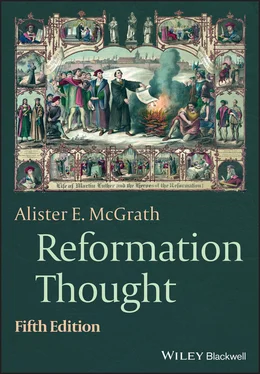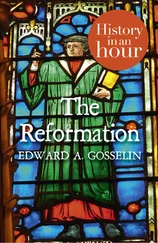The origins of the Reformed church lie with developments within the Swiss Confederation – a loose confederation of cantons, including Zurich. Whereas the Lutheran Reformation had its origins primarily in an academic context, the Reformed church owed its origins more to a series of attempts to reform the morals and worship of the church (but not necessarily its doctrine ) according to a more biblical pattern. Although most of the early Reformed theologians – such as Huldrych Zwingli (1484–1531) – had an academic background, their reforming programs were not academic in nature. They were mainly concerned with reforming the practices (such as the worship) of the churches in the main Swiss cities, including Zurich, Berne, and Basle.
Whereas Luther was convinced that the doctrine of justification by faith was of central significance to his program of social and religious reform, early Reformed thinkers appear to have had relatively little interest in doctrine, let alone this one specific doctrine. Their reforming program was institutional, social, and ethical, in many ways similar to the demands for moral and structural reform originating from within the humanist movement. We shall consider the ideas of humanism in some detail presently (pp. 43–71); for the moment it is important simply to note that all the major early Reformed theologians had links with the humanist movement which were not shared by Luther, who regarded it with some suspicion.
The consolidation of the Reformed church is generally thought to have begun with the stabilization of the Zurich reformation after Zwingli’s death in battle (1531) under his successor, Heinrich Bullinger (1504–75), and to have ended with the emergence of Geneva as its power-base and John Calvin (1509–64) as its leading spokesman in the 1550s. The gradual shift in power within the Reformed church (initially from Zurich to Berne, and subsequently from Berne to Geneva) took place over the period 1520–60, eventually establishing both the city of Geneva, its political system (republicanism), and its religious thinkers (initially Calvin, and after his death Theodore Beza) as predominant within the Reformed church. This development was consolidated through the establishment of the Genevan Academy (founded in 1559), at which Reformed pastors were trained for service throughout Europe.
The term “Calvinism” is often used to refer to the religious ideas of the Reformed church. Although this practice is still encountered in the literature relating to the Reformation, it is now generally discouraged. It is becoming increasingly clear that later sixteenth-century Reformed theology draws on sources other than the ideas of Calvin himself. To refer to later sixteenth- and seventeenth-century Reformed thought as “Calvinist” implies that it is essentially the thought of Calvin – and it is now generally agreed that Calvin’s ideas were modified subtly – though not inappropriately – by his successors through a natural process of development and reflection. (We shall explore this development in relation to the doctrine of predestination on pp. 231– 45.) The term “Reformed” is now preferred to “Calvinist,” whether to refer to those churches (mainly in Switzerland, the Lowlands, and Germany) or religious thinkers (such as Theodore Beza, William Perkins, or John Owen) which were grounded in Calvin’s celebrated religious textbook The Institutes of the Christian Religion or to church documents (such as the famous Heidelberg Catechism ) based upon it.
A study of the development of the term “Calvinist” suggests that it dates from the 1560s, when a significant alteration in the political situation in the German territories took place. Germany had been seriously destabilized in the 1540s and early 1550s by conflicts between Lutherans and Catholics, and it was widely recognized that such conflicts were damaging to the Empire. The Peace of Augsburg (September 1555) settled the religious question in Germany by allocating certain areas of Germany to Lutheranism and the remainder to Catholicism – the famous principle often referred to using the Latin slogan cuius regio , eius religio (“your region determines your religion”). No provision was made for the Reformed faith, which was then a minority presence within Germany.
In February 1563, however, the Heidelberg Catechism was published (see p. 272), demonstrating that Reformed theology had gained a firm foothold in this hitherto Lutheran region of Germany. This catechism was immediately attacked by Lutherans as being “Calvinist” – in other words, foreign. The term “Calvinist” was used by German Lutherans to attempt to discredit this new and increasingly influential document, by implying that it was unpatriotic. Given the original polemical associations of the term “Calvinist,” historians have searched for a more neutral term to refer to this movement. The term “Reformed” is widely used for this reason, and is to be preferred. However, some theologians continue to use the term “Calvinism.”
The Reformed wing of the Reformation has been of particular importance in shaping Christianity within the English-speaking world. Puritanism, which figures so prominently in seventeenth-century English history and is of such fundamental importance to the religious and political views of New England in the seventeenth century and beyond, is a specific form of Reformed Christianity. To understand the religious and political history of New England or the ideas of writers such as Jonathan Edwards (1703–58), for example, it is necessary to come to grips with at least some of the theological insights and part of the religious outlook of Puritanism, which underlie their social and political attitudes. It is hoped that this work will help with this process of familiarization.
The Radical Reformation (Anabaptism)
Every intellectual movement has its conservatives and radicals. The New Testament’s demand to “test everything” and “hold fast what is good” (1 Thessalonians 5:21) points to a critical process of sifting and refining, aimed at capturing and then preserving what was “good” about European Christianity and church life at this time. The British philosopher Roger Scruton puts his finger on two themes that lie at the heart of a conservative way of thinking: “the conviction that good things are more easily destroyed than created,” and a “determination to hold on to those good things” in the face of social and cultural change. 2While Luther was clear that there were major issues with the church’s teaching on grace, he comes across as an essentially conservative thinker, determined to retain as much as he could of legitimate traditional Christian belief and practice.
Others, however, were more radical, holding that it was necessary to start all over again, setting to one side what had been inherited from the past and reconstructing Christianity in a manner that liberated it from past cultural and political captivities. The movement that is now generally known as “the radical Reformation” was actually quite diverse, reflecting a series of theological, cultural, and political agendas. Some, such as the Socinians and other anti-Trinitarians and rationalists, believed that Christianity had become trapped in a series of irrational beliefs, such as the doctrine of the Trinity; it was time to extricate Christianity from such false turns. Others, such as Caspar von Schwenckfeld, pointed to the need for spiritualizing key Christian ideas. Given the diversity of this movement, it is difficult to survey it properly and fully. For our purposes, we shall focus on the section of the movement that is generally known as “Anabaptism.” Not all radicals were Anabaptists in either the strict or broad sense of the term; nevertheless, this section of the radical Reformation perhaps had the greatest impact on the Reformation as a whole, and thus deserves special attention.
Читать дальше

![О Генри - Возрождение Каллиопы [The Reformation of Calliope]](/books/407342/o-genri-vozrozhdenie-kalliopy-the-reformation-of-c-thumb.webp)









